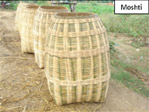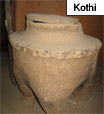Storage Units of Tribal Communities of Gujarat
While world today is struggling to find methods to reduce wastage of agricultural produce especially of cereals and pulses and maintain quality during storage, the local communities and tribes have some indigenous methods for the same. The storage methods range from mud structures to modern bins. The containers are made from a variety of locally available materials differing in design, shape, size and functions. The materials used include paddy straw, wheat straw, wood, bamboo, reeds, mud, bricks, cow dung etc. These storage units are being covered with the leaves of Sag Tectona grandis orcow dung. Because of that the grain which is stored will keep same and with out contamination for many years.
Moshti, Kothi, Khotar, Porasi and earthern pots are some of the community used traditional storage containers/structures.

Moshti is a grain storage container made out of bamboo. The base is usually round and has a wide opening at the top. The height varies. Mainly Gamit, Vasava, Dholiya patel communities in southern Gujarat use these storage containers.

The Porasi is plastered with mud and cow dung mixture to prevent spillage and pilferage of grains. The top is also plastered with mud and cow dung mixture or covered with paddy straw or gunny bags. It has been found to be used by Nayaka community from Godhara and Panchmahal districts of Gujarat

Kothi is used to different grains. A room is constructed with a large door for pouring grains. A small outlet is made at the bottom for taking out the grains. It is being used mainly in Kutchh especially among Rabari communities.


